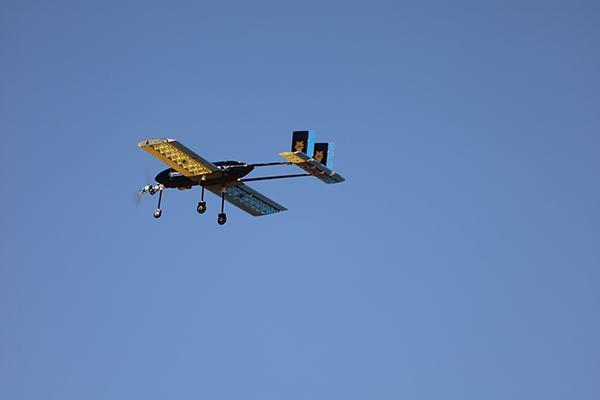Design, Build, Fly Team Takes Ninth Place in International Competition

June 1, 2023 - UCI’s Design, Build Fly team finished ninth out of 99 teams from 14 countries in the 2022-23 American Institute of Aeronautics and Astronautics (AIAA) Design, Build, Fly competition. The Anteaters finished first among 11 teams from California universities competing in the event. Hosted by Raytheon Technologies, the DBF flyoff was held at the Tucson International Modelplex Park Association in Tucson, Arizona, the weekend of April 13-16.
Now in its 27th year, the contest is an opportunity for university students to apply real-world aircraft design experience by giving them the opportunity to validate their analytic studies. Student teams design, fabricate and demonstrate the flight capabilities of an unmanned, electric powered, radio-controlled aircraft to meet a specified preassigned mission. Each year, there is a new challenge.
UCI’s team, advised by Jacqueline Huynh, assistant professor of mechanical and aerospace engineering, and graduate student Nathan Yeung, includes 15 undergraduate students majoring in either mechanical engineering or aerospace engineering. All members were new to the project this year. Ten team members traveled to Arizona for the flyoff.
The mission for 2023 was to design, build and test an aircraft to execute electronic warfare missions. The aircraft, payloads and all tools required to assemble the aircraft had to fit into a shipping box that complied with airline checked baggage limits on size and weight. The teams had to complete three flight missions, each taking off within 60 feet. The first was a staging flight with no payload for three laps within five minutes. The second was a surveillance flight with an electronics package, and the score was based on the weight of the payload times the number of laps flown in 10 minutes. The final mission was a jamming flight with a ½ inch PVC pipe antenna attached on the wing tip; the scored based on the length of the antenna divided by the time to fly three laps. Teams were also required to complete a ground mission demonstrating structural capability of the aircraft wing attachment. The total score was the product of the total mission score and design report score plus participation score.

UCI’s aircraft was the only one with double booms, connecting the fuselage to the wings. And their initial design report scored 86.27, landing them 14th in line for the inspection and flight missions.
“We were very excited to be there,” said Daniel Steiner, a junior in mechanical engineering. “The first day was very hectic and we didn’t get our first inspection until the second day. Then we failed on a technicality, a fracture in our motor mount.”
The team figured out the cause and fixed the aircraft in order to pass inspection on their second attempt. For each flight mission, they had only five minutes to pull the parts from the box and put the plane together before flying. They got their assembly down to four minutes and 30 seconds.

Mission one went well for the UCI team, they easily completed three laps. On mission two, the one with the payload, the UCI aircraft lost thrust during take-off; the power was cut. The plane took a nose dive, which bent the landing gear. After inspection by a judge, since the gear wasn’t broken only bent, they were able to continue the mission. For mission three - jamming flight with a wing tip vertical antenna - the team repaired the aircraft as best they could and voted on a strategy to use the medium height antenna and just fly laps as fast as possible.
“We optimized the aircraft to carry the largest antenna and still maintain control and just told the pilot to go as fast as possible,” said Luis Zamora, a project lead and fourth-year student in aerospace engineering. The team had previously flown with a shorter antenna length with their first prototype, and after learning how the aircraft behaved, they were able to decide on an appropriate antenna length for the mission. They were able to complete the mission in two minutes and two seconds.
Judges look for aircraft with a balanced design possessing good demonstrated flight handling qualities and practical and affordable manufacturing requirements that provide a high vehicle performance. First place went to RWTH Aachen University, second place went to University of Ljubljana and third place went to Embry-Riddle Aeronautical University - Daytona Beach. Eleven California schools participated. San Diego State finished 11th, UCLA 15th and Stanford 21st.
“I have been continuously impressed with the DBF team this year and their top in the state of California position, despite consisting of entirely new members. When challenges emerged during the competition weekend, they were able to calmly yet diligently address them. It makes me proud for UC Irvine’s aerospace engineering program,” said Huynh.
– Lori Brandt
